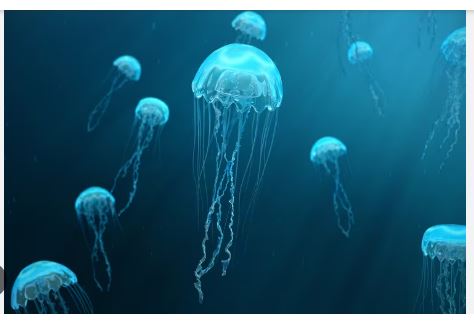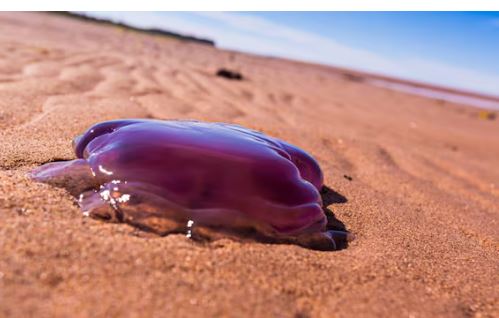
Jellyfish, primarily from the phylum Cnidaria (classes Scyphozoa, Cubozoa, and Hydrozoa), are gelatinous, free-swimming marine animals known for their bell-shaped bodies and trailing tentacles armed with stinging cells (nematocysts). With over 2,000 species, they inhabit every ocean, from coastal shallows to the deep sea, playing critical roles in marine ecosystems as predators and prey.
These creatures exhibit diverse forms, from tiny to massive, with some tentacles stretching meters long. They feed on plankton, small fish, or other jellyfish, playing key roles as predators and prey in marine ecosystems. Their ability to form blooms can impact fisheries and tourism, reflecting their ecological influence and sensitivity to environmental changes.
Jellyfish thrive in varied conditions, adapting to warm or cold waters, with some species tolerating brackish environments. Their simple anatomy, lacking brains or bones, relies on a nerve net for movement and feeding. Symbiotic algae in some species provide energy via photosynthesis, showcasing their ecological adaptability.

Types of Jellyfish
Moon Jellyfish
Scientific Name: Aurelia aurita
Moon jellyfish are translucent, saucer-shaped scyphozoans with a bell 10–40 cm in diameter, fringed with short tentacles and four cloverleaf-shaped gonads visible through the bell. Found globally in temperate and tropical coastal waters (6–31°C), they feed on plankton using nematocysts, with a mild sting harmless to humans. Their bioluminescence creates glowing displays at night, and they thrive in aquariums due to their adaptability. Moon jellies can form blooms, impacting zooplankton populations, and are a food source for sea turtles.
Lion’s Mane Jellyfish
Scientific Name: Cyanea capillata
The largest jellyfish species, Lion’s Mane has a bell up to 2 m wide and tentacles stretching 36.5 m, resembling a lion’s mane. Its red-brown bell darkens with age, and its 1,200+ neurotoxic tentacles deliver painful but rarely fatal stings. Inhabiting cold waters of the Arctic, North Atlantic, and North Pacific, it feeds on fish and smaller jellies. Blooms can disrupt fishing nets, and its size makes it a key predator in its ecosystem.
Box Jellyfish
Scientific Name: Chironex fleckeri
This cubozoan, known as the Australian box jellyfish, has a cube-shaped bell (30 cm) and up to 60 tentacles, each 3 m long, packed with potent nematocysts. Found in Indo-Pacific coastal waters, its venom can cause cardiac arrest in minutes, with at least 79 fatalities recorded since 1883. Its complex eyes and rapid movement (6 m/min) aid predation on fish and shrimp. Protective clothing is essential for swimmers in its range due to its lethality.
Portuguese Man O’ War
Scientific Name: Physalia physalis
Not a true jellyfish but a siphonophore (class Hydrozoa), this colonial organism has a blue-purple gas-filled float (up to 30 cm) and tentacles extending 50 m. Found in warm Atlantic, Pacific, and Indian Ocean waters, its venomous stings cause intense pain and, rarely, death. It feeds on fish and plankton, drifting with currents. Often found in clusters, it poses risks to beachgoers, especially after storms.
Cauliflower Jellyfish
Scientific Name: Cephea cephea
Also called the crown jellyfish, this scyphozoan has a bluish-purple bell (up to 50 cm) with wart-like projections, resembling a cauliflower. Found in the Indo-Pacific and Atlantic, it feeds on zooplankton via filter feeding, with a mild sting. Its short lifespan (6 months) and tendency to form blooms can deplete plankton, affecting local ecosystems. Its striking appearance makes it a focal point in aquariums.
Crystal Jellyfish
Scientific Name: Aequorea victoria
This hydrozoan, found off North America’s West Coast, has a transparent, 10 cm bell with 150+ wispy tentacles. It’s bioluminescent, glowing green-blue due to green fluorescent protein (GFP), used in molecular biology research (Nobel Prize, 2008). Its mild sting is harmless to humans, and it feeds on small plankton. Its transparency aids camouflage in open waters, though blooms can impact fisheries.
White-Spotted Jellyfish
Scientific Name: Phyllorhiza punctata
This scyphozoan has a 50 cm bell with white spots on its tentacles, native to the western Pacific but invasive in the Gulf of Mexico and Caribbean. A filter feeder, it consumes vast amounts of zooplankton (13,000 gallons daily), disrupting ecosystems by outcompeting native species. Its mild sting is harmless to humans, but blooms threaten fisheries by depleting food for fish and crustaceans.
Mauve Stinger
Scientific Name: Pelagia noctiluca
A small scyphozoan (10 cm bell), the mauve stinger has a purple-pink, bioluminescent bell and long tentacles delivering painful stings. Found in warm and temperate waters, including the Mediterranean, it feeds on plankton and small fish. Blooms, driven by overfishing and warming seas, can clog fishing nets and sting swimmers, impacting tourism. Its glow aids nighttime predation.
Cannonball Jellyfish
Scientific Name: Stomolophus meleagris
This scyphozoan, with a round, 20 cm bell resembling a cannonball, inhabits Atlantic and Pacific coastal waters. Its mild sting poses little risk to humans, and it’s a delicacy in some Asian cuisines. Feeding on zooplankton, it forms large swarms that support shrimp fisheries by providing food. Its firm bell aids buoyancy in turbulent coastal zones.
Black Sea Nettle
Scientific Name: Chrysaora achlyos
This deep-sea scyphozoan, found off Southern California, has a 1 m red-black bell and 25 m tentacles. Its painful sting and large size make it a formidable predator of plankton and small fish. Rarely seen due to its deep habitat, it blooms unpredictably, impacting fisheries. Its dark color blends with deep waters, aiding ambush predation.
Immortal Jellyfish
Scientific Name: Turritopsis dohrnii
This tiny hydrozoan (4.5 mm bell) is biologically immortal, reverting to its polyp stage via transdifferentiation after maturity. Found in Mediterranean and temperate waters, its non-venomous sting is harmless. It feeds on microscopic plankton, and its immortality raises research interest for regenerative medicine. However, predation limits its lifespan in the wild.
Flower Hat Jellyfish
Scientific Name: Olindias formosus
This hydrozoan, with a 15 cm translucent bell and fluorescent, streamer-like tentacles, inhabits shallow waters off Japan, Brazil, and Argentina. Its painful sting causes rashes but isn’t fatal. Feeding on small fish, it lures prey with vibrant colors. Active at night, it rests on the seafloor by day, making it a rare sighting.
Atolla Jellyfish
Scientific Name: Atolla wyvillei
This deep-sea scyphozoan (15 cm bell) is bioluminescent, emitting flashes to deter predators in the Atlantic and Pacific. Its trailing tentacle ambushes prey like copepods. Known as the alarm jellyfish, its flashes attract larger predators to distract attackers. Its deep habitat (1,000–4,000 m) limits human encounters, but it’s vital to deep-sea food webs.
Upside-Down Jellyfish
Scientific Name: Cassiopea xamachana
This scyphozoan rests bell-down on the seafloor in warm Caribbean and Florida waters, with oral arms upward. Its 30 cm bell hosts symbiotic algae (zooxanthellae) for photosynthesis, supplementing its diet of plankton. Its mild sting irritates humans, and its unique behavior supports small marine life sheltering in its arms.
Nomad Jellyfish
Scientific Name: Rhopilema nomadica
This scyphozoan, native to the Indo-Pacific but invasive in the Mediterranean, has a 10–90 cm white bell with short, stinging tentacles. Its potent sting causes painful burns, impacting swimmers and tourism. Feeding on plankton, it forms massive blooms, clogging fishing nets and power plant intakes. Thriving in warm waters (20–30°C), it benefits from climate change. Its spread is monitored to protect coastal ecosystems.
Sea Wasp
Scientific Name: Chiropsella bronzie
A small cubozoan (5 cm bell) from Indo-Pacific coastal waters, the sea wasp has four tentacle clusters with potent nematocysts, causing severe pain but rarely death. Its box-shaped bell and advanced vision (24 eyes) aid predation on shrimp and small fish. Found in shallow reefs, it poses risks to swimmers. Its rapid swimming (4 m/min) makes it elusive, requiring protective gear in its range.
Blue Blubber Jellyfish
Scientific Name: Catostylus mosaicus
This scyphozoan, native to Indo-Pacific estuaries, has a 30 cm blue or white bell and short, fluffy oral arms for filter-feeding zooplankton. Its mild sting irritates but is harmless to humans. Common in Australian waters, it forms blooms that support crab fisheries by providing prey. Its adaptability to brackish waters makes it a key species in estuarine food webs.
Pink Meanies
Scientific Name: Drymonema larsoni
This scyphozoan, found in the Gulf of Mexico and Caribbean, has a 1 m pinkish bell and long, trailing tentacles. Unlike most jellyfish, it preys on other jellies (e.g., moon jellyfish), using a painful sting. Blooms can deplete jellyfish populations, altering food webs. Its rare sightings and predatory behavior make it a subject of ecological research.
Compass Jellyfish
Scientific Name: Chrysaora hysoscella
Named for its compass-like bell markings, this scyphozoan has a 30 cm yellowish-brown bell with 32 radial patterns and long tentacles. Found in Atlantic and Mediterranean waters, its painful sting affects swimmers. Feeding on plankton and small fish, it thrives in temperate seas (10–20°C). Blooms disrupt fisheries, but it’s prey for leatherback turtles, balancing its ecological impact.
Fried Egg Jellyfish
Scientific Name: Cotylorhiza tuberculata
This Mediterranean scyphozoan has a 35 cm yellow bell resembling a fried egg, with short, club-like tentacles hosting symbiotic algae for photosynthesis. Its mild sting is harmless, making it safe for swimmers. Feeding on plankton, it thrives in warm shallows (20–25°C). Its blooms attract juvenile fish, creating mini-ecosystems, though they can clog nets.
Pacific Sea Nettle
Scientific Name: Chrysaora fuscescens
This scyphozoan, found along North America’s Pacific coast, has a 50 cm golden-brown bell and 4 m tentacles delivering painful stings. Feeding on plankton and small fish, it thrives in cool waters (10–18°C). Blooms impact fisheries and aquaculture, but its vibrant colors make it a star in aquariums like Monterey Bay. Its role as prey supports sea turtles and sunfish.
Irukandji Jellyfish
Scientific Name: Carukia barnesi
This tiny cubozoan (2 cm bell) from northern Australia has four tentacles with potent venom causing Irukandji syndrome—severe pain, nausea, and, rarely, death. Feeding on plankton, it inhabits tropical waters (25–30°C). Its small size and transparency make it hard to spot, posing risks to swimmers. Research into its venom aids medical advancements for pain management.
Narcomedusae
Scientific Name: Solmissus spp.
This hydrozoan group, found in deep oceans worldwide, has a 10 cm bell with short, stiff tentacles and no oral arms. Feeding on gelatinous prey like salps, it uses a mild sting. Its deep-sea habitat (500–2,000 m) limits human encounters, but it’s vital to deep-sea food webs. Its unique bell shape aids buoyancy in high-pressure environments.
Helmet Jellyfish
Scientific Name: Periphylla periphylla
This deep-sea scyphozoan, found in all oceans, has a 20 cm conical, red-brown bell and 12 long tentacles. Bioluminescent, it glows to deter predators in depths of 800–1,500 m. Feeding on copepods and small fish, it migrates vertically to feed. Its blooms in fjords can disrupt plankton dynamics, but its deep habitat minimizes human impact.
Flame Jellyfish
Scientific Name: Rhopilema esculentum
This scyphozoan, native to the western Pacific, has a 60 cm reddish bell and short tentacles with a mild sting. A delicacy in Asian cuisines, it’s harvested sustainably for its high protein content. Feeding on plankton, it thrives in warm waters (20–28°C). Its blooms support fisheries but can clog nets, requiring careful management.
Comb Jellyfish
Scientific Name: Mnemiopsis leidyi
Not a true jellyfish but a ctenophore, this 10 cm translucent species uses iridescent comb rows for locomotion, not nematocysts. Native to the Atlantic but invasive in the Black Sea, it feeds on zooplankton, collapsing fisheries by outcompeting fish larvae. Found in coastal waters (5–30°C), its blooms highlight overfishing impacts. It lacks a sting, posing no human risk.
Barrel Jellyfish
Scientific Name: Rhizostoma pulmo
This scyphozoan, common in the Atlantic and Mediterranean, has a 90 cm white bell and frilly oral arms, not tentacles, delivering a mild sting. Feeding on plankton via filter feeding, it thrives in warm waters (15–25°C). Blooms provide food for leatherback turtles but can overwhelm beaches. Its size makes it a key species in coastal ecosystems.
Hair Jellyfish
Scientific Name: Cyanea lamarckii
This scyphozoan, found in North Atlantic and Baltic waters, has a 30 cm blue or yellow bell with fine, hair-like tentacles delivering a moderate sting. Feeding on plankton and small fish, it thrives in cool waters (5–15°C). Its blooms can clog fishing gear, but it’s prey for seabirds and fish, balancing its ecological role.